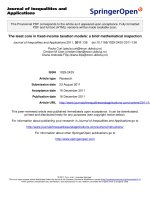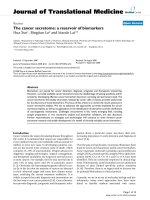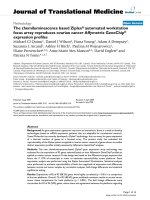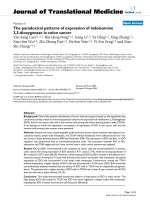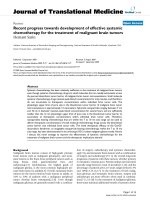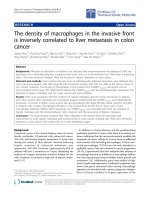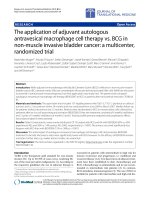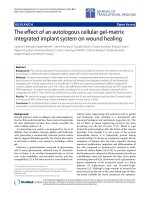Báo cáo hóa học: " The first hydrophobic region of the HPV16 E5 protein determines protein cellular location and facilitates anchorage-independent growth" potx
Bạn đang xem bản rút gọn của tài liệu. Xem và tải ngay bản đầy đủ của tài liệu tại đây (2.29 MB, 10 trang )
BioMed Central
Page 1 of 10
(page number not for citation purposes)
Virology Journal
Open Access
Research
The first hydrophobic region of the HPV16 E5 protein determines
protein cellular location and facilitates anchorage-independent
growth
Caroline Lewis
1
, Marta F Baro
2
, Margarita Marques
2
, Myriam Grüner
1
,
Angel Alonso
1
and Ignacio G Bravo*
3
Address:
1
Deutsches Krebsforschungszentrum, Im Neuenheimer Feld-242, 69120 Heidelberg, Germany,
2
Universidad de León, 24071 León, Spain
and
3
Experimental Molecular Evolution. Institute for Evolution and Biodiversity. Westfaelische Wilhems University Muenster, Hüfferstrasse 1,
Germany
Email: Caroline Lewis - ; Marta F Baro - ; Margarita Marques - ;
Myriam Grüner - ; Angel Alonso - ; Ignacio G Bravo* -
* Corresponding author
Abstract
The human papillomavirus type 16 E5 protein (HPV16 E5) is 83 amino acids in length and contains
three well-defined hydrophobic regions. The protein is expressed at very limited amounts in
transfected cells and the absence of specific antibodies has strongly hampered functional analyses.
To investigate the relationship between structure and function we have synthesized a codon-
adapted version of the gene (hE5) and prepared a series of N-terminal and C-terminal deletions.
Immunofluorescence analyses show colocaliation of the protein with calnexin, an ER marker, EEA-
1, an early endosomes marker, and Lamp-2, a lysosomal marker. No major colocalization was found
between hE5 and the Golgi marker 58 K. Whereas deletions at the C-terminal end of the protein
do not greatly alter the localisation pattern, deletion of the first hydrophobic region results in loss
of colocalisation with the ER, early endosomes and lysosomes. Further, we show that while the
complete E5 protein confers to HaCaT cells the property to grow in an anchorage-independent
manner, deletion of the first hydrophobic region results in loss of growth in soft agar. We conclude
that the first hydrophobic region of the E5 protein largely determines the biological properties of
the viral protein.
Background
Certain papillomaviruses (PVs) present a coding region
between the E2 and L2 open reading frames. The proteins
herein encoded are usually named E5, although they can
be classified into four different types according to their
phylogeny and to their correlation with abnormal growth
[1]. HPV16 E5 is the prototype of the E5-α group, and is
the most investigated E5 protein. The HPV16 E5 is 83
amino acids in length and mainly localises in the Golgi
apparatus and the endoplasmic reticulum [2-4].
The cellular effects associated to the expression of
HPV16E5 are multiple [5]. Experimental work has dem-
onstrated that HPV16 E5 binds the 16 K proteolipid sub-
unit of the membrane proton pump, although this
binding does not appear to be responsible for the E5-
mediated epidermal growth factor receptor (EGFR) over-
Published: 26 February 2008
Virology Journal 2008, 5:30 doi:10.1186/1743-422X-5-30
Received: 31 January 2008
Accepted: 26 February 2008
This article is available from: />© 2008 Lewis et al; licensee BioMed Central Ltd.
This is an Open Access article distributed under the terms of the Creative Commons Attribution License ( />),
which permits unrestricted use, distribution, and reproduction in any medium, provided the original work is properly cited.
Virology Journal 2008, 5:30 />Page 2 of 10
(page number not for citation purposes)
activation [4,6,7]. The binding region has been mapped to
amino acids 54 to 78 [8] or to amino acids 41 to 54 of the
E5 protein [7], and in both cases this binding was unre-
lated to the overactivation of the EGFR. In addition, data
have been published showing that HPV16 E5 binds the
platelet-derived growth factor as well as the EGF receptors,
although contradictory results have been reported [9,10].
Regarding the interaction of the E5 proteins with the
immune system, it has been proposed that its expression
blocks the transport of the major histocompatibility com-
plexes to the cell surface [11,12], either by direct interac-
tion with the heavy chain of the human leucocitary
antigen molecule [13] or indirectly via interaction with
calnexin [14]. Finally, it has been suggested that many of
the multiple and disparate effects associated to E5 could
eventually arise from modifications in membrane compo-
sition and dynamics subsequent to protein expression
[15].
The strong hydrophobicity of the protein and the absence
of valuable specific antibodies have hampered E5
research. Most of the experimental work with the protein
has been performed using a tagged gene and antibodies to
the ligated epitope. In addition, the rare use of the viral
codons by mammalian cells makes expression of the pro-
tein very weak, thus difficulting the identification of the
epitope-tagged proteins as well as the analysis of its puta-
tive biological effects. In most cases, expression has been
limited to the demonstration of the corresponding RNA
[16]. For these reasons, the group led by Schlegel synthe-
sized an E5 gene adapting the codon usage to that found
in mammalian cells [17]. Using this "codonadapted" gene
they observed a strong expression of the protein and
found that the protein mainly localised in the endoplas-
mic reticulum [17]. This contrasts with other published
results using the "wild-type" codons showing a clear colo-
calisation of the E5 protein with markers specific for the
Golgi apparatus [2].
Hydropathic analysis of the protein reveals three hydro-
phobic regions [1], the first being considered to be the
putative transmembrane region, although no experimen-
tal work has so far demonstrated this point (see [18] for
BPV1 E5). At the HPV16 E5 C-terminal end, a short
hydrophilic tract seems to be involved in protein-protein
associations and also to be responsible for the activity of
the viral protein towards the EGF receptor [7,8].
We have performed a series of experiments aiming to ana-
lyse the correlation between the primary structure of the
protein and its cellular localisation and biological func-
tion. For this, deletions encompassing fragments of the N-
terminal or C-terminal ends of the E5 protein were con-
structed, and the cellular localisation and biological
effects of these modified genes were analysed. Our results
indicate that the first hydrophobic region of HPV16 E5
determines the subcellular localisation of the protein,
despite no canonic localisation signal can be identified.
Finally, cells transformed with the full-length HPV16 E5
gene were able to grow in an anchorage-independent
manner, whereas transformants lacking the first hydro-
phobic domain do not grow in soft agar.
3.1 Results
3.1. Preparation of recombinants and expression of the
proteins
A recombinant containing the human codon-adapted
sequence of HPV16 E5 (hE5), an α-type E5 protein [1]
(EF463082) was cloned into the vector pFlag-CMV4
(Sigma). Cloning was performed deleting the methionine
start codon of the viral protein and ligating the rest of the
E5 gene the vector Flag epitope. The HPV16 E5 protein is
83 amino acids long, with three well-defined hydropho-
bic regions (Fig. 1). In an initial series of experiments, we
produced series of deletions starting at the first viral
amino acid after methionine and with stop codons at
amino acids histidine 75 (hE5H75), arginine 58
(hE5R58), or arginine 30 (hE5R30). N-terminal deletions
were prepared starting at amino acids 30 (R30hE5) or 58
(R58hE5) and ending at amino acid 83.
To analyse expression of the protein mutants, HEK-293T
cells were transfected with pFlag-CMV4 recombinants and
24 hours later protein extracts were prepared. The proteins
were separated by polyacrylamide gel electrophoresis and
blotted with antiflag antibodies. As shown in Fig. 2, all
recombinants were expressed in HEK-293Tcells albeit
with different efficiencies. Whereas deletion hE5R58 was
strongly expressed, deletion R30hE5 was expressed at
much lower levels. No protein could be observed using
deletion R58hE5. Results concerning this mutant will
therefore not be considered in this manuscript.
These results were reproducible when using different DNA
batches and performing the transfections on different
days, suggesting that the differences observed among the
deletions are of intrinsic nature and not experimental arte-
facts.
3.2. Cellular localisation of wild-type and mutant E5
α
proteins
It has been reported that, when expressed from a codon-
adapted gene, the E5α protein is mostly localised at the
endoplasmic reticulum [17]. To identify the cellular com-
partment where the deletions were located, we used
immunofluorescence colocalisation experiments via spe-
cific antibodies against markers for the Golgi apparatus
(58 K), the early endosomes (EEA-1), the endoplasmic
reticulum (calnexin), and the lysosomes (LAMP-2).
Virology Journal 2008, 5:30 />Page 3 of 10
(page number not for citation purposes)
In full-length transfectants carrying the codon-adapted
version of the gene a strong colocalisation with calnexin
was found (Fig. 3A), consistenly with previous reports
[14]. This contrasts with the distribution detected when
the full-length gene carrying the viral codons was trans-
fected. In this case almost no colocalisation with calnexin
was observed (Fig. 4), also consistently with previous
reports [2]. Further, all Cterminal deletions showed a
strong colocalisation with calnexin. Surprisingly, no colo-
calisation was found between the N-terminal mutant
R30hE5 and calnexin, indicating that the mutant protein
is not localised in the ER (Fig. 3B).
Our immunofluorescence analyses further demonstrate
that neither the codonadapted full-length gene nor any of
the codon-adapted deletion mutants colocalised with the
58 K marker for the trans-Golgi (Fig. 3A, B, Fig. 5). This
again contrasts with the picture observed when the full-
length viral gene was transfected, where colocalisation of
E5 and 58 K was observed (Fig. 4).
Clear colocalisation with EEA-1 was found for both the
full-length gene and the Cterminal deletions, indicating
the presence of the protein in the early endosomes.
Finally, a strong colocalisation of the wild type protein
and deletion hE5H75 with Lamp-2 was observed, suggest-
ing that degradation of the protein -or at least of this par-
ticular deletion- takes place in the lysosomes (Fig. 5).
Interestingly, no colocalisation with any of the markers
used could be demonstrated for mutant R30hE5 (Fig. 3B),
despite the clear expression of the protein as demon-
strated in the Western blots (see Fig. 2). The immunoflu-
orescence pictures suggest that this mutant protein is
associated to some membranous structures and not ran-
A) Hydropathic analysis of the HPV16 E5α protein using a window of 9 amino acids and the Kyte&Doolittle indexFigure 1
A) Hydropathic analysis of the HPV16 E5α protein using a window of 9 amino acids and the Kyte&Doolittle
index. HR: hydrophobic region. B) Schematic representation of the mutants employed in our experiments. Sequences were
cloned into the Eco Rl-Bam Hl restriction sites of the vector pFlag-CMV4. In all cases the start methionine amino acid was
deleted. All recombinants were confirmed by sequencing.
hE5R30
FLAG
R58hE5
FLAG
hE5R58
FLAG
020406080
Hydrophobic i ty i ndex
(after Kyte & Dool ittle)
-1
0
1
2
3
4
HR 1 (11-29)
HR 2 (36-54)
HR 3 (59-76)
FLAG
hE5
hE5H75
FLAG
R30hE5
FLAG
Virology Journal 2008, 5:30 />Page 4 of 10
(page number not for citation purposes)
domly distributed in the cytosol (Fig. 3B). A summary of
the immunofluorescence data is shown in table 1.
3.3. Growth in soft agar
Expression of HPV16-E5 in primary keratinocytes from a
codon-adapted gene does not result in alterations of lig-
and-mediated EGFR phosphorylation, PI 3-K or c-Src acti-
vation but promotes anchorage-independent growth in
soft agar [19]. Thus, we chose keratinocyte growth in soft
agar as a read-out for the biological activity of the protein
and the corresponding deletions. HaCaT cells were trans-
duced with retroviruses carrying the complete gene or the
different deletions, plated onto soft agar, and 21 days later
colony number and size were scored. The values obtained
for colony size followed a exponential decrease-like distri-
bution, but could not be properly fitted to any reasonably
simple function (an example is shown in Fig. 6C). We
have therefore addresed the statistic comparisons by
means of robust estimators (Huber estimator for central
tendency and median absolute deviation for dispersion)
and by means of robust comparisons (Wilcoxon-Mann-
Withney test).
Non-transduced HaCaT cells were only marginally able to
grow under non-adhesive conditions, confirming pub-
lished reports [20]. An interesting observation in this
experiment was that both genes, codon-adapted and orig-
inal viral codons, stimulated growth in soft agar to similar
extents, despite the differences in protein expression and
in subcellular localisation. As shown in Fig. 6, the full-
length genes as well as the deletions investigated, with the
exception of deletion R30hE5, increased the number of
colonies and the colony size of keratinocytes growing in
soft agar. The effect of the empty vector on colony forma-
tion was noteworthy. As shown in Fig. 6A, HaCaT cells
transduced with the empty pLXSN retroviral vector were
able to form colonies in softagar, albeit the size did not
differ from the untransduced controls (p = 0.1121, Wil-
coxon-Mann-Whitney test).
Analysis of the colony size revealed that cells transduced
with a codon-adapted E5 gene were larger than cells trans-
duced with the wild-type gene (p = 3.285e-3, Wilcoxon-
Mann-Whitney test) (Fig. 6B). All three codon-adapted C-
terminal deletions induced also the growth of larger colo-
Expression of the codon-adapted version of HPV16 E5α and corresponding deletionsFigure 2
Expression of the codon-adapted version of HPV16 E5α and corresponding deletions. HEK- 293T cells were trans-
fected with the pFlag-pCMV recombinants and 24 hours thereafter SDS extracts were prepared. Proteins were separated by
acrylamide gel electrophoresis and blotted with antibodiesagainst the Flag-epitope.
Virology Journal 2008, 5:30 />Page 5 of 10
(page number not for citation purposes)
nies than the wild-type gene, and showed no statistical
significant differences in size compared to the full-length
codon-adapted transductants. Finally, the few colonies
grown after transduction with the N-terminal deletion
hR30E5 were did not differ in size from control HaCaT
cells (p = 0.907, Wilcoxon-Mann-Whitney test).
In summary, keratinocytes transduced with constructs
encompassing the first hydrophobic region of HPV16 E5
showed increased growth under anchorageindependent
conditions. Furthermore, full-length codon-adapted
transductants gave rise to more colonies and to larger col-
onies than full-length wild-type HPV16 E5 transductants.
4. Discussion
In this communication we present experimental evidence
demonstrating expression in HEK-293T cells of a codon-
adapted version of the HPV16 E5α protein, as well as of a
series of N- or C-terminal deletions. Expression of mutant
protein hR58E5 could not be demonstrated in western
blots. Whether the failure to identify expression of this
mutant is due to inherent protein instability is unknown.
Immunofluorescence experiments with markers specific
for different cellular compartments show colocalisation of
HPV16 hE5α with calnexin, indicating that the protein is
mainly localised at the endoplasmic reticulum. This find-
ing is in agreement with previous results obtained also
using codon-adapted versions of the E5 gene [14,17].
Interestingly, these results contrast with published reports
showing the protein mainly associated with the Golgi
apparatus [2,3]. It must be noted however that the initial
reports refer to genes encoding the original, non-human-
adapted viral codons. A possible explanation for this dif-
ference may lie in the large amounts of E5 protein synthe-
sised from the codon-adapted genes, which will probably
accumulate in the ER with the cell being unable to further
transport the protein to the Golgi compartment. Similar
remarkable shifts in cellular localisation and/or function
have also been reported for the L1 [21], E6 [22] and E7
[23] proteins from different PVs after humanisation of the
codon usage. Experimental differences between the effects
of the expression of wild-type and humanised PV genes
highlights again the physiological importance of the
biased codon usage in PVs [24,25]. The colocalisation
Cellular localisation in of hE5 protein and deletions expressed from codon-adapted genesFigure 3
Cellular localisation in of hE5 protein and deletions expressed from codon-adapted genes. HaCaT cells cells were
transfected with the complete gene or with the R30hE5 deletion. Colocalisation with markers specific for endoplasmic reticu-
lum (Calnexin) Golgi (58 K), early endosomes (EEA1) or lysosomes (Lamp-2) was analysed by double immunofluorescence.
Virology Journal 2008, 5:30 />Page 6 of 10
(page number not for citation purposes)
demonstrated for E5α with the early endosomal marker
EEA-1 is most interesting since a physical association
between HPV16 E5α and the 16 K subunit of the proton
ATPase has already been demonstrated. This association
has been made responsible for the modulation of the
internal pH value of the endosomes [4,6]. In addition, the
presence of HPV16 E5α in early endosomes is in agree-
ment with the functional observation of an E5-dependent
pH alteration in endosomes, as previously described
[17,26].
Cellular localisation in HaCaT cells of GFP-E5 protein expressed from wild-type viral geneFigure 4
Cellular localisation in HaCaT cells of GFP-E5 protein expressed from wild-type viral gene. Colocalisation with
markers specific for endoplasmic reticulum (Calnexin) and Golgi (58 k) was analysed by double immunofluorescence.
Table 1: Colocalisation in HaCaT cells of E5 proteins with markers specific for ER, trans-Golgi network, early endosomes, or
lysosomes.
Colocalisation with
Calnexin (endoplasmic
reticulum)
58 k (trans-Golgi network) EEA1 (early endosomes) Lamp-1 (lysosomes)
Construct
hE5 ++ - +++ +
hE5H75 +/- - +/- +
hE5R58 + - ++ +
hE5R30 ++ - ++ +
R30hE5 - - - (dubious +/-) -
Relative intensity of colocalisation is shown by symbols: -, no colocalisation; -/+, occasional colocalisation; +, weak colocalisation; +++, strong
colocalisation.
Virology Journal 2008, 5:30 />Page 7 of 10
(page number not for citation purposes)
Growth of transduced HaCaT cells in soft agarFigure 6
Growth of transduced HaCaT cells in soft agar. Cells were plated on soft agar and overlayed with DMEM containing 50
ng/mL EGF. After 21 days growth dishes were stained with Cristal violet and the colony number (A) or colony size (B, C) was
calculated. A) average values for the number of colonies generated in each different transfectant. Error bar encompass 95%
confidence interval of themean. Inset A) P-values for a one-tail Student's t-test. Values with statistically significant differences
have been shadowed. B) values for the Huber central estimator for the colony size -arbitrary units- in each different transfect-
ant. Error bar encompass the median absolute deviation. The vertical scale has been broken in the interval 0–4 since the small-
est colony size detectable with the hardware/software employed was four units. Dashed line marks the 95% confidence value
for the colony size in the HaCaT control cell lines. Inset B) P-values for a Wilcoxon-Mann-Whitney test; H0 = median values of
both populations are similar. Values with statistically significant differences have been shadowed. C) Example showing the his-
tograms for distribution of colony size in control HaCaT cells -black- and in hE5 transfectants -red. Continuous lines mark the
corresponding values for the average of the population. Dashed lines mark the corresponding values for the Huber central
estimators.
colony size
HaCaT pLXSN E5 hE5 hE 5H75 hE5R58 hE5R30 hR30E5
0
4
6
8
10
12
number of colonies
HaCaT pLXSN E5 hE5 hE5H75 hE5R58 hE5R30 hR30E5
0
50
100
150
200
250
300
HaCaT pLXSN E5 hE5
pLXSN
0.1121
E5
0.009243
0.05989
hE5
0.0001926
0.000000947 0.0003285
hE5H75
0.0000541
9.516E-10 4.827E-07 0.3321
hE5R58
0.001434
0.0002128 0.03658 0.07592
hE5R30
0.00040402
0.000003019 0.0007887 0.6974
hR30E5 0.907 0.06402 0.003415 0.00001632
A
B
C
colony size
0 5 10 15 20 25 30 35 40
frequency
0,0
0,1
0,2
0,3
0,4
control keratinocytes
hE5-transduced keratinocytes
Huber estimator for control keratinocytes
average for hE5-transduced keratinocytes
average for control keratinocytes
Huber estimator for hE5-transduced keratinocyte
HaCaT
pLXSN E5 hE5
pLXSN
0.0007605
E5
8.91136E-05
0.036431767
hE5
2.40143E-05
0.047535503
0.357004459
hE5H75
0.000372886
0.003360067
0.020297261
0.014459685
hE5R58
0.000106757
0.002415911
0.036248862
0.01906695
hE5R30
0.003710543
0.025544182
0.089866056
0.071604119
hR30E 5
0.113616029
0.001052866 0.000118073 3.47982E-05
Virology Journal 2008, 5:30 />Page 8 of 10
(page number not for citation purposes)
The observation that the presence of the first hydrophobic
region is necessary for localisation of the protein to the
ER, early endosomes or lysosomes is noteworthy, mainly
because of the lack of a canonical signal peptide. Deletion
of the first 30 amino acids (recombinant R30hE5) results
in changes in both localisation pattern and biological
effects of the protein. This mutant showed no loss colocal-
isation of the Flag epitope with 58 K, calnexin, EEA-1 or
Lamp-2. Moreover, in the anchorageindependent growth
experiments this mutant strongly inhibited colony growth
and the size of the few growing colonies was clearly
reduced in comparison with that of the full length gene.
Further, the immunofluorescence pictures showed a
punctuated distribution for this mutant, suggesting that
the protein was associated with some kind of vesicular
structure, although we were not able to identifiy it.
The results shown in this communication demonstrate
that the expression of theHPV16 E5 protein increases the
number and the size of HaCaT cell colonies growing in
soft-agar. The results were the same for both the wild-type
version of the E5 gene and for a codon-optimised version,
despite strong differences in expression intensity between
these two genes. This suggests that the amount of
expressed E5 protein is not decisive for colony number
but determines the number of cells and therefore the col-
ony size (see Fig. 6). The data here detailed represent the
first quantitative description of the ability of HPV16 E5 to
Cellular localisation of hE5 protein and deletions expressed from codon-adapted genesFigure 5
Cellular localisation of hE5 protein and deletions expressed from codon-adapted genes. HaCaT cells were trans-
fected with the complete gene or with the deletions hE5H75, hE5R30 or R30hE5. Colocalization with markers specific for
Golgi (58 K, pictures b, c), early endosomes (EEA1, pictures e, f) or lysosomes (Lamp-1, pictures h, i) was analysed by double
immunofluorescence. Overlays are shown in pictures c, f and I, respectively.
Virology Journal 2008, 5:30 />Page 9 of 10
(page number not for citation purposes)
promote growth in soft agar. A previous qualitative
description in the same sense had been provided by
Suprynowicz and coworkers, in primary keratinocytes
[19]. The effects of HPV16 E5 on uncontrolled cell growth
and malignisation seem therefore to be multiple. Thus,
although an increased expression of the protein seems to
shorten the in vitro life span of primary keratinocytes
[17], the expression of HPV16 E5 allows human keratino-
cytes to grow in soft agar ([19] and the present paper).
Finally, as a correlate at the organismic level, the expres-
sion of HPV16 E5 in transgenic mice leads to the develop-
ment of endophytic papillomas, precursors to
carcinomas, and contributes to the promotion and pro-
gression stages of carcinogenesis [27].
Regarding the dissection of the differential implication of
the three transmembrane domains of HPV16 E5 in the
biological effects of the protein, our finding that Ntermi-
nal deletion mutant R30hE5 was unable to promote
growth in soft-agar is interesting since this mutant did not
show colocalisation with any of the markers used in our
immunofluorescence experiments. The molecular mecha-
nisms responsible for this effect are unknown. Computer
analysis of the protein identifies the first hydrophobic
region of HPV16 E5 as a putative trans-membrane seg-
ment [1,28]. It may be speculated that interactions of with
other membrane proteins determine the biological activ-
ity of the viral protein. This is further supported by
recently published work showing that E5 interacts in the
ER with calnexin through the first hydrophobic segment
[14]. This interaction results in retention of the HLA class
I molecules in the Golgi apparatus, with concomitant
down-regulation of its plasma membrane expression
[11,13,14].
Thus, we can conclude that the first 30 amino acids of the
HPV16 E5α protein play a crucial role in the biological
properties of the protein. This region determines cellular
localisation of the protein, binding to the chaperone cal-
nexin, and anchorageindependent growth in a human
keratinocyte cell line.
Materials and methods
Recombinants
The nucleotide sequence of the codon-adapted HPV16 E5
gene was synthesized in vitro adapting the wild type
codons to the human codon usage (GeneArt, Regens-
burg), and the corresponding sequence has been depos-
ited in GenBank under EF463082
. The full-length gene
and deletions encompassing different fragments of the
protein were cloned into the Eco RI-Bam Hl sites of
recombinant pLXSN (Fig. 1). For immunofluorescence
and western blot experiments, hE5 sequences were cloned
into the vector pFlag-CMV4. For comparing subcellular
distribution of the codon-adapted genes and the original
viral sequence, a GFP-E5 fusion recombinant was synthe-
sized by ligating the E5 wild-type coding region to the C-
terminal end of the green fluorescence protein gene of the
pEGFP vector [3].
2.2. Cell culture, transfections, and transductions
HaCaT cells, an immortalized human keratinocyte cell
line, were cultured in DMEM supplemented with 10 %
FCS and antibiotics. Transfections with the pCMV4
recombinants were performed using Lipofectamine 2000
as indicated by the manufacturer. 24–48 hours after trans-
fection the cells were fixed in 4% paraformaldehyde. Dou-
ble immunofluorescence was performed using polyclonal
antibodies against the Flag tag, and monoclonal antibod-
ies against the 58 K Golgi protein (Sigma-Aldrich), endo-
plasmatic reticulum marker calnexin (Santa Cruz), the
lysosomal marker LAMP-2 (antibody H4B4, University of
Ohio) and the early endosomal marker EEA-1 (Transduc-
tion Laboratories). Pictures were obtained using a confo-
cal microscope LEICA DMRBE.
For the analysis of protein expression, recombinants were
transfected into HEK-293T cells. 24 hours after transfec-
tion protein extracts were prepared and immunobloted
with antibodies to the Flag epitope. Reacting bands were
revealed with ECL.
HaCaT cells were transduced with retroviruses as
described [29]. In brief, retroviruses were generated in
Phoenix cells transfected with the corresponding recom-
binants. The cell supernatants containing the retroviruses
were used to transduce HaCaT cells in the presence of
polybrene. After 24 hours growth, 800 μg/mL of the selec-
tion antibiotic G-418 were added and the cells were fur-
ther cultured for the desired time.
2.3. Anchorage-independent growth
The growth characteristics of transduced HaCaT cells
under anchorage-independent conditions were analysed
by growing the cells in soft agar. 2 × 10
4
, 5 × 10
4
or 10
5
cells transduced with the corresponding retroviral con-
structs were suspended in 2× MEM containing 20 % FCS
and mixed with the same volume of 0.7% agar at 42°C.
Cells were plated onto 0.5% agar in medium and then
overlayed with 200 μL of medium containing G-418 (800
μg/μL) and 50 ng/mL EGF. Each point was performed
twice in triplicate. The experiment was repeated twice
using different retroviral supernatants and different kerat-
inocyte cultures. Each point thus gathers information
from at least 12 agar plates. Colony number and size were
scored after 3 weeks growth, using crystal violet staining
and the ImageQuant software (Amersham). Due to the
non-normal distribution of the colony size, the robust
Huber estimator was used for central tendency. Compari-
son among colony size values was performed with the
Publish with BioMed Central and every
scientist can read your work free of charge
"BioMed Central will be the most significant development for
disseminating the results of biomedical research in our lifetime."
Sir Paul Nurse, Cancer Research UK
Your research papers will be:
available free of charge to the entire biomedical community
peer reviewed and published immediately upon acceptance
cited in PubMed and archived on PubMed Central
yours — you keep the copyright
Submit your manuscript here:
/>BioMedcentral
Virology Journal 2008, 5:30 />Page 10 of 10
(page number not for citation purposes)
Wilcoxon-Mann-Whitney test, implemented in R. Com-
parison among number of colonies was performed with a
one-side Student's t-test.
Authors' contributions
CL performed the initial cloning, constructed the gene
deletions and confocal microscopy. MFB and MM per-
formed the soft-agar growth experiments. MG performed
the retroviral subcloning. AA designed the experiment and
drafted the manuscript. IGB designed the experiment,
analysed the data and drafted the manuscript. All authors
have agreed on the final version of the manuscript.
Acknowledgements
IGB is the recipient of a Volkswagen Stiftung professorship under the pro-
gram "Evolutionary Biology".
References
1. Bravo IG, Alonso A: Mucosal human papillomaviruses encode
four different E5 proteins whose chemistry and phylogeny
correlate with malignant or benign growth. J Virol 2004,
78:13613-13626.
2. Auvinen E, Alonso A, Auvinen P: Human papillomavirus type 16
E5 protein colocalizes with the antiapoptotic Bcl-2 protein.
Arch Virol 2004, 149:1745-1759.
3. Oetke C, Auvinen E, Pawlita M, Alonso A: Human papillomavirus
type 16 E5 protein localizes to the Golgi apparatus but does
not grossly affect cellular glycosylation. Arch Virol 2000,
145:2183-2191.
4. Conrad M, Bubb VJ, Schlegel R: The human papillomavirus type
6 and 16 E5 proteins are membrane- associated proteins
which associate with the 16- kilodalton pore-forming pro-
tein. J Virol 1993, 67:6170-6178.
5. Bravo IG, Alonso A, Auvinen E: Human papillomavirus type 16
E5 protein. Papillomavirus Rep 2004, 15:1-6.
6. Straight SW, Herman B, McCance DJ: The E5 oncoprotein of
human papillomavirus type 16 inhibits the acidification of
endosomes in human keratinocytes. J Virol 1995, 69:3185-3192.
7. Adam JL, Briggs MW, McCance DJ: A mutagenic analysis of the
E5 protein of human papillomavirus type 16 reveals that E5
binding to the vacuolar H+- ATPase is not sufficient for bio-
logical activity, using mammalian and yeast expression sys-
tems. Virology 2000, 272:315-325.
8. Rodriguez MI, Finbow ME, Alonso A: Binding of human papillo-
mavirus 16 E5 to the 16 kDa subunit c (proteolipid) of the
vacuolar H+-ATPase can be dissociated from the E5- medi-
ated epidermal growth factor receptor overactivation. Onco-
gene 2000, 19:3727-3732.
9. Hwang ES, Nottoli T, Dimaio D: The HPV16 E5 protein: expres-
sion, detection, and stable complex formation with trans-
membrane proteins in COS cells. Virology 1995, 211:227-233.
10. Conrad M, Goldstein D, Andresson T, Schlegel R: The E5 protein
of HPV-6, but not HPV-16, associates efficiently with cellular
growth factor receptors. Virology 1994, 200:796-800.
11. Ashrafi GH, Brown DR, Fife KH, Campo MS: Down-regulation of
MHC class I is a property common to papillomavirus E5 pro-
teins. Virus Res 2006, 120:208-211.
12. Ashrafi GH, Haghshenas MR, Marchetti B, O'Brien PM, Campo MS:
E5 protein of human papillomavirus type 16 selectively
downregulates surface HLA class I. Int J Cancer 2005,
113:276-283.
13. Ashrafi GH, Haghshenas M, Marchetti B, Campo MS: E5 protein of
human papillomavirus 16 down regulates HLA class I and
interacts with the heavy chain via its first hydrophobic
domain. Int J Cancer 2006, 119:2105-2112.
14. Gruener M, Bravo IG, Momburg F, Alonso A, Tomakidi P: The E5
protein of the human papillomavirus type 16 down-regulates
HLA-I surface expression in calnexin-expressing but not in
calnexin-deficient cells. Virol J 2007, 4:116.
15. Bravo IG, Crusius K, Alonso A: The E5 protein of human papil-
lomavirus type 16 modulates composition and dynamics of
membrane lipids in keratinocyte membranes. Arch Virol 2005,
150:231-246.
16. Oelze I, Kartenbeck J, Crusius K, Alonso A: Human papillomavi-
rus type 16 E5 protein affects cell-cell communication in an
epithelial cell line. J Virol 1995, 69:4489-4494.
17. Disbrow GL, Sunitha I, Baker CC, Hanover J, Schlegel R: Codon
optimization of the HPV-16 E5 gene enhances protein
expression. Virology 2003, 311:105-114.
18. Burkhardt A, Willingham M, Gay C, Jeang KT, Schlegel R: The E5
oncoprotein of bovine papillomavirus is oriented asymmet-
rically in Golgi and plasma membranes. Virology 1989,
170:334-339.
19. Suprynowicz FA, Disbrow GL, Simic V, Schlegel R: Are transform-
ing properties of the bovine papillomavirus E5 protein
shared by E5 from high-risk human papillomavirus type 16?
Virology 2005, 332:102-113.
20. Scholle F, Bendt KM, Raab-Traub N: Epstein-Barr virus LMP2A
transforms epithelial cells, inhibits cell differentiation, and
activates Akt. J Virol 2000, 74:10681-10689.
21. Mossadegh N, Gissmann L, Müller M, Zentgraf H, Alonso Á, Tomakidi
P: Codon optimization of the human papillomavirus 11 (HPV
11) L1 gene leads to increased gene expression and forma-
tion of virus-like particles in mammalian epithelial cells. Virol-
ogy 2004, 326:57-66.
22. Samorski R, Gissmann L, Osen W: Codon optimized expression
of HPV 16 E6 renders target cells susceptible to E6-specific
CTL recognition. Immunol Lett 2006, 107:41-49.
23. Cid-Arregui A, Juarez V, Zur HH: A synthetic E7 gene of human
papillomavirus type 16 that yields enhanced expression of
the protein in mammalian cells and is useful for DNA immu-
nization studies. J Virol 2003, 77:4928-4937.
24. Bravo IG, Müller M: Codon usage in papillomavirus genes: prac-
tical and fuctional aspects. Papillomavirus Rep 2005, 16:1-9.
25. Zhao KN, Liu WJ, Frazer IH: Codon usage bias and A+T content
variation in human papillomavirus genomes. Virus Res 2003,
98:95-104.
26. Schapiro F, Sparkowski J, Adduci A, Suprynowicz F, Schlegel R, Grin-
stein S: Golgi alkalinization by the papillomavirus E5 oncopro-
tein. J Cell Biol 2000, 148:305-315.
27. Maufort JP, Williams SM, Pitot HC, Lambert PF: Human papilloma-
virus 16 E5 oncogene contributes to two stages of skin car-
cinogenesis. Cancer Res 2007, 67:6106-6112.
28. Alonso A, Reed J: Modelling of the human papillomavirus type
16 E5 protein. Biochim Biophys Acta 2002, 1601:9-18.
29. Zhang B, Spandau DF, Roman A: E5 protein of human papilloma-
virus type 16 protects human foreskin keratinocytes from
UV B-irradiation-induced apoptosis. J Virol 2002, 76:220-231.
